Click here to see the charm of Bubbleback in a video ↓
Rolex has many popular models, but the one that is especially loved by vintage watch enthusiasts is the Bubbleback, right?
The reason is that the groundbreaking technology and design of the time, contained in a small space, continues to attract fans around the world today.
In this article, we will explain the history and appeal of Bubble Back from various angles.
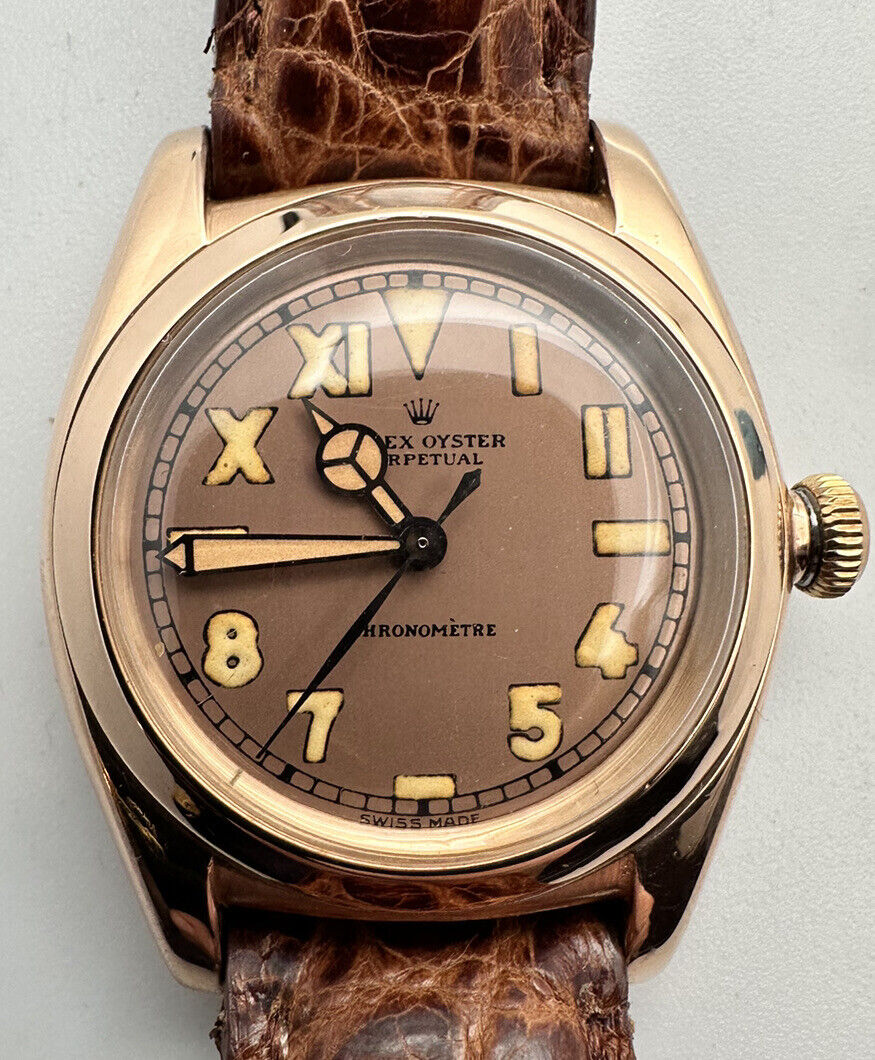
The table of contents looks like this.
1. The History and Appeal of Rolex Bubbleback
2. Interesting Bubbleback Dial Variations
3. What types of bezels and hands are there?
4. Look at the evolution of the movement
Finally, here is a summary.
The History and Appeal of the Rolex Bubbleback
The Bubble Back was born in 1933 as the world's first waterproof watch and was in production until 1955.
In the second half of the 1920s, watch manufacturers were competing more and more fiercely to develop the technology to create automatic movements.
Meanwhile, in 1931, Rolex began producing watches based on a model designed by Ebauer, a caliber manufacturer.
There was a race to develop automatic movements, but it does not seem that each company was developing them with the aim of making waterproof watches.
This is because, at the time, Rolex's Bubble Back was the market leader in waterproof watches, and no other company could follow suit.
Rolex understood that a movement housed in an airtight waterproof case needed to be automatic, so it appears that they developed an automatic movement with waterproof functionality.
This was the "autorotor," which would later become the basis for the automatic winding perpetual mechanism.
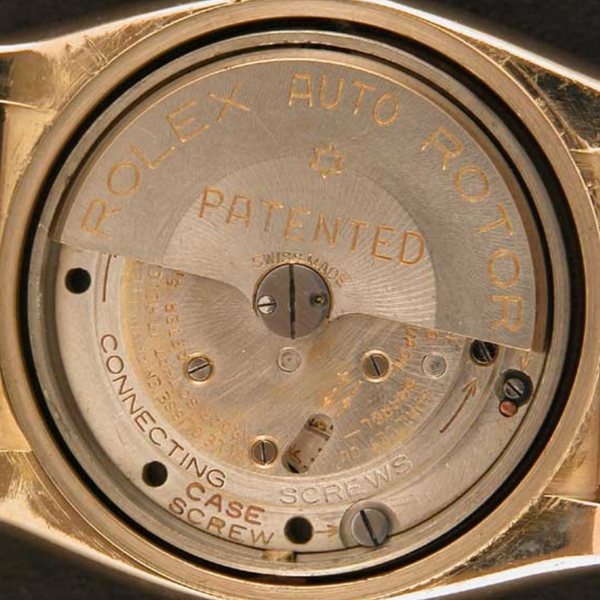
Then, in 1931, the “Perpetual” automatic winding mechanism, which did not require winding, was completed.

It was a manually wound movement with an automatic winding mechanism that had a rotor that rotated 360 degrees both clockwise and counterclockwise.
This was simpler than the "bumper" type that had been released at the time, but it was more efficient at winding and more durable.
As a result, the rotor was mounted on top of the manually-wound base movement; to achieve this, the back cover was expanded and a thick rotor was pushed in; because this rotor appears to be inflated like a bubble, it came to be called a " Bubble Back."
 https://www.watchcollectinglifestyle.com/
https://www.watchcollectinglifestyle.com/
Interesting Bubbleback Dial Variations
Bubble Bags were highly valued by collectors and experienced a huge boom from the 1970s to the 1990s, and are still sought after by many people today.
In addition to the groundbreaking technology that laid the foundation for automatic winding, its design now represents the distinctive watchmaking era of the 1930s and 1940s, and its appeal lies in the refinement it exudes with the elegance of Art Deco style.
By the way, this Bubble Back is one of the Oyster Perpetual designs, and there are many variations in dials and movements.
The Art Deco style is particularly popular, and is also attractive for its diverse dial designs.
Now let's take a look at the various dial types available on this Bubbleback.
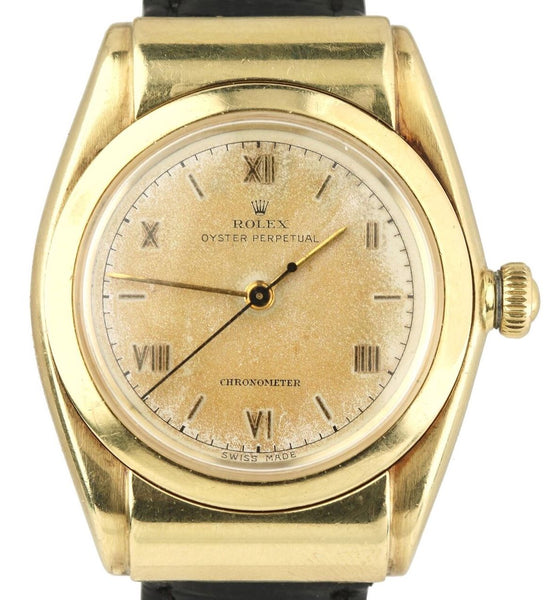
※Flying Roman
It has a Roman index, but there is also a version where all the numbers are Roman.
Most of them are applied indexes that stand out in three dimensions, giving them a sense of luxury.

*Arabic index
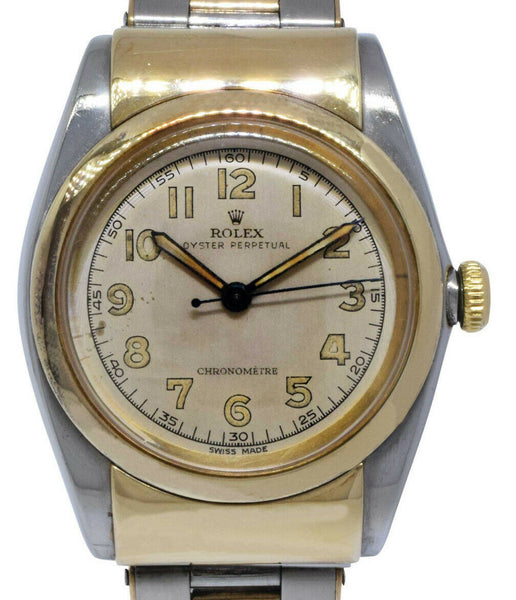
*Big Arabic index

*Flying Arabic index
Next are Arabic, Big Arabic, and flying Arabic indexes, but Arabic and flying Arabic indexes are often applied.
The difference between Arabia and Big Arabia is in the size of the numbers.
Big Arabia is basically displayed in print.
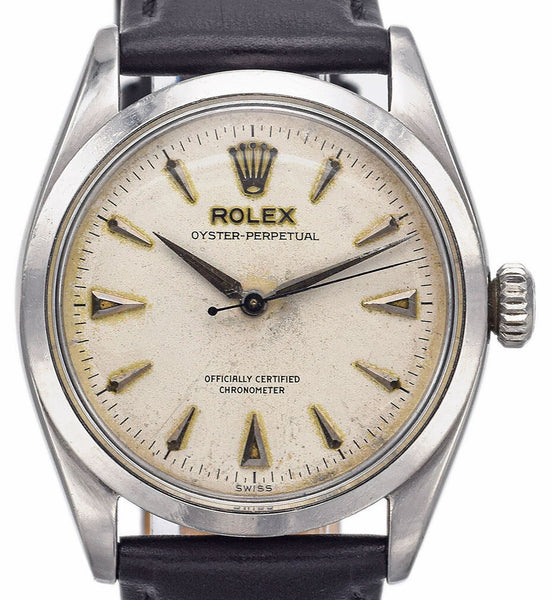
※Wedge index

*Bar index
It has wedge and bar indexes and a simple dial, but I get the impression that many of them have the chronometer notation at the 6 o'clock position.

*California dial (unique dial)
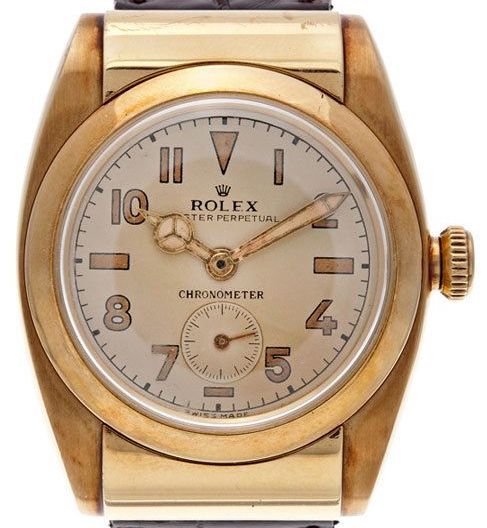
※Fly California (Fly Unique)
Also known as the California dial (known as the unique dial in Japan), it combines Arabic and Roman numerals with bars at the 3, 6, and 9 o'clock positions.
Among the Bubblebacks, the most popular dials are those with unique dials, which fetch higher prices than the others.

*24-hour display
The dial features a 24-hour clock, which is something you don't see very often, but what makes this watch unique is that the 24-hour clock is printed in red and the indexes are Arabic indexes.
All of the dials are cool, but the unique dials are particularly popular worldwide.
Also, this is just my personal opinion, but I have the impression that among these dials, it is quite rare to see one that is all Roman indexes.
The Bubble Back with Perpetual movement was extremely robust for its time and was extremely popular due to its case construction and waterproofness.
Bubble Backs, which are so carefully crafted from the design stage onwards, can still be found in good condition even after nearly 90 years.
In addition, most Rolex Oyster Perpetuals from the so-called fourth generation, produced from 1943 onwards, are chronometer certified, although rarer ones may not display this on the dial.
The dials introduced here are just a few of the most popular, and while there are subtle differences between each, there are still many more types of Bubble Back dials.

https://www.telegraph.co.uk/luxury/watches/rolex-bubbleback-classic-watch-world-forgot/
What types of bezels and hands are there?
The dial isn't the only interesting thing about the Bubbleback.
The case is also distinctive, and there are multiple patterns of hands.
Let's take a look at them here.
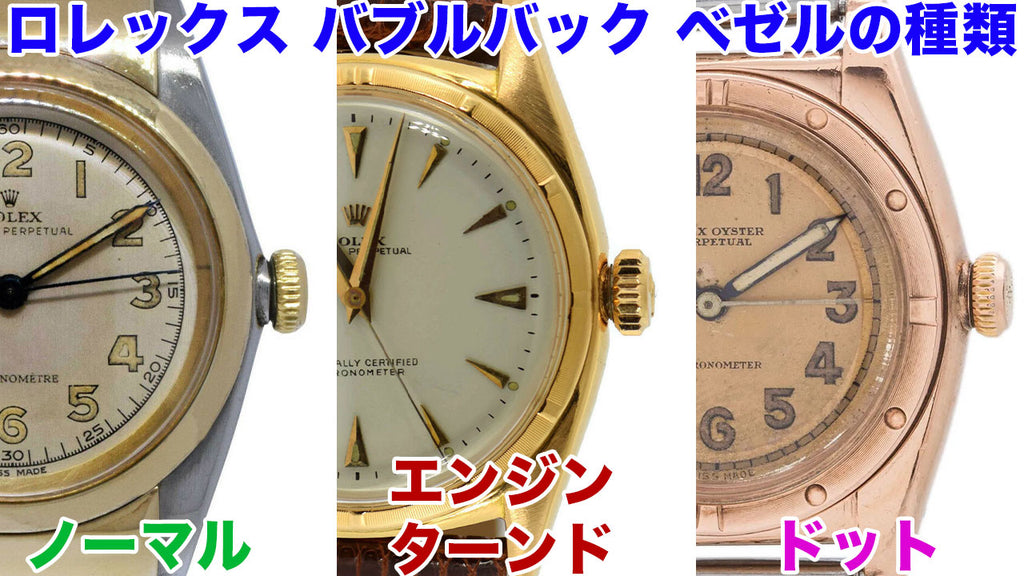
Now take a look at this image.
First, the bezel on the far left is the normal version.
Generally, the normal bezel is the most common.
And in the middle is the engine turned bezel.
What sets it apart is the fine cuts made into the bar, with new decorations placed every five minutes.
And the rightmost one is a dot.
As its name suggests, this watch is decorated with dots every five minutes, but the 12, 3, 6, and 9 o'clock positions are decorated with bars.
Furthermore, these bezels are not integrated into the case, and come in a variety of patterns, such as a yellow gold engine turned bezel on a stainless steel case, or a dot bezel on a stainless steel case.
Now let's look at the needle.

Now, please take a look at the image.
Starting from the top left, they are Leaf, Bar, Pencil, and going down the row they are Dauphin, Benz, and Diamond.
The hands are also designed to be combined with the dial; for example, the Big Arabic has pencil hands.
Regular Arabic or Roman indexes tend to use bars or leaves.
As you can see, various needle patterns were made, but the most popular is still the Mercedes Benz needle, isn't it?
It seems that the most common combinations of Mercedes-Benz hands are unique dials or unique, jumping dials.
Also, although it is a diamond needle, this needle is a very rare type and is not often seen.
Let's take a look at the evolution of the movement
Early perpetuals had a weakness: although they could rotate 360 degrees, they only actually wound clockwise.
Therefore, the challenge was how to wind the rotor as efficiently as possible in this one-way direction, which made the specific gravity of the rotor very important.
The rotor also needed to be thick to give it its weight, and space was needed to store it.
Therefore, the earlier the bubble back, the greater the bulge of the back cover.
The movement used at that time was Cal. 620, which was an automatic winding mechanism added to the original manual winding Cal. 600.
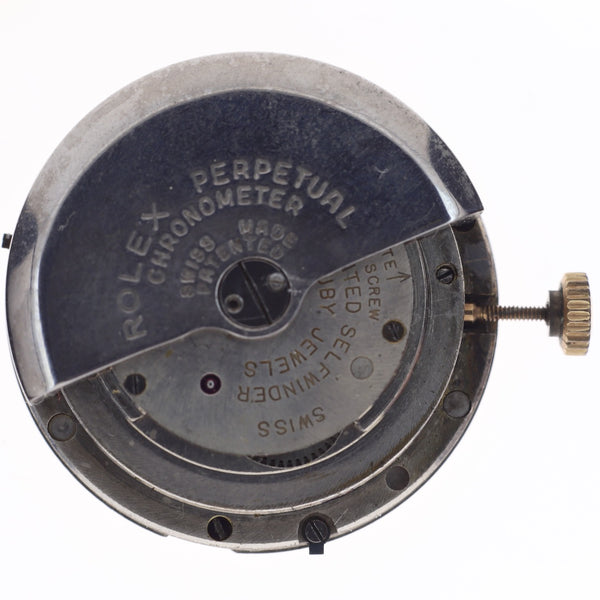
However, Rolex was not happy with the awkward case back, which was too wide.
To overcome this, we will have to make a major change in our winding efficiency.
Until then, the specific gravity of the rotor had been thought to be an important factor in winding efficiency, but the idea was that winding efficiency could be improved by utilizing inertia and winding in both directions.
These goals were made possible by the Cal. 1030, produced around 1950. Since then, the movement has adopted a bidirectional winding system, which has further improved winding efficiency, resulting in the creation of a movement whose technology is still used today.
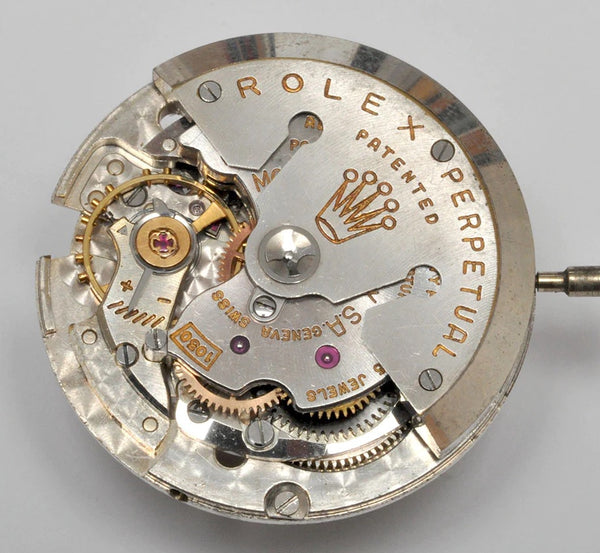
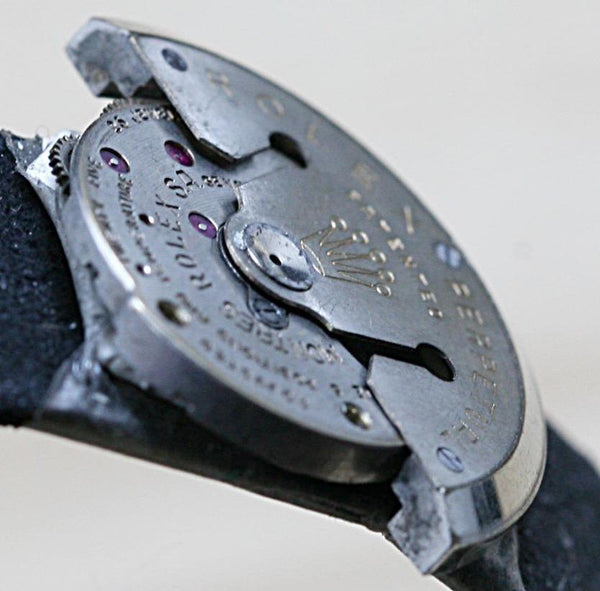
Please see the image below.
By placing a heavy metal on the outer circumference of the rotor, it becomes possible to increase inertia and wind the rotor more efficiently.
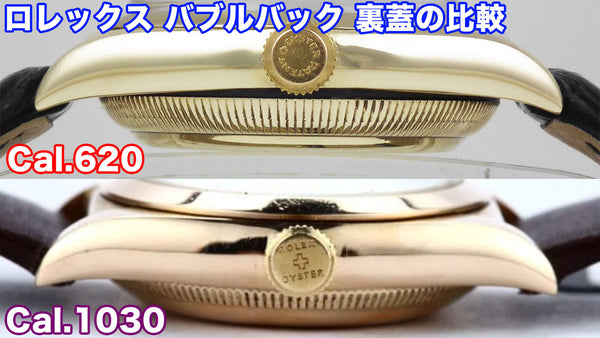
Please see the image below.
It may be a little hard to tell from the image, but the back cover was quite wide in the Cal. 620 era, but it is a little thinner with the Cal. 1030.
summary
 https://www.watchcollectinglifestyle.com/
https://www.watchcollectinglifestyle.com/
The Bubble Back is primarily made from stainless steel, and is available in 14K or 18K yellow and pink gold case versions.
The size is generally 33mm to 34mm.
Although it is smaller than today's standard watches, this makes it elegant, comfortable to wear, and simply not out of place in today's world.
This is because the 1930s to 1950s was the era of Art Deco, a time when design and originality were put to the test.
It's this willingness to experiment, coupled with futuristic design that creates immense beauty, that many people find to be the true appeal of Bubbleback.
Today's huge clocks are cool, but if you look at them not just based on their size, but also taking into account their design, durability, and the historical background they were made from, you'll see a whole different kind of coolness.
Bubble bags come in a variety of designs, so why not try to find one that suits your taste?













